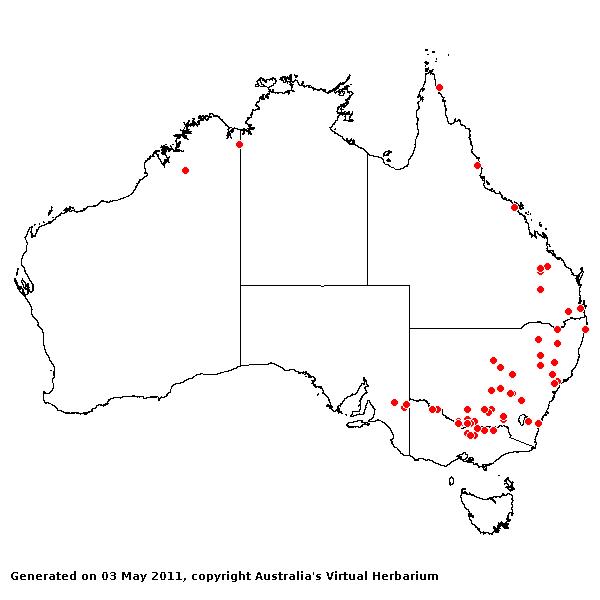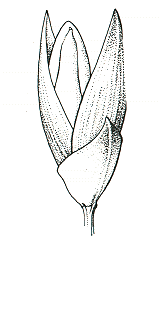Panicum coloratum* L. Mant. Pl.
1: 30 (1767).
Classification. (GPWG 2001) : Subfamily
Panicoideae. Paniceae.
Type of Basionym or
Protologue Information: Egypt: Cairo:, Forsskal s.n. (HT:
LINN-80.45).
Key references
(books and floras): [2002] D.Sharp & B.K.Simon, AusGrass, Grasses of
Australia, [2006] J.Jessop, G.R.M.Dashorst, F.M.James, Grasses of South
Australia (459), [2008] S.W.L.Jacobs, R.D.B.Walley & D.J.B.Wheeler, Grasses
of New South Wales.
Illustrations:
[2006] J.Jessop, G.R.M.Dashorst, F.M.James, Grasses of South Australia (459, Fig. 391), [2008] S.W.L.Jacobs,
R.D.B.Whalley & D.J.B.Wheeler, Grasses of New South Wales, 4th edn
(315).
Habit. Perennial. Rhizomes present. Stolons absent. Culms erect or
decumbent, 15–120 cm tall, 6–12 -noded. Mid-culm internodes glabrous. Mid-culm
nodes glabrous or pubescent (rarely). Lateral branches sparsely branched.
Leaf-sheaths glabrous on surface or hairy. Leaf-sheath auricles absent. Ligule
an eciliate membrane or a fringed membrane, a ciliate membrane. Leaf-blades
linear, (3–)10–30 cm long, (2–)4–10 mm wide. Leaf-blade surface smooth,
glabrous or indumented.
Inflorescence.
Inflorescence compound, a panicle. Panicle oblong, 4–30(–40) cm long, evenly
furnished or with spikelets clustered towards branch tips.
Spikelets.
Spikelets pedicelled. Fertile spikelets 2-flowered, the lower floret barren
(rarely male), the upper fertile, comprising 1 basal sterile florets,
comprising 1 fertile floret(s), without rachilla extension, elliptic or ovate,
dorsally compressed, 2–3.2 mm long. Rhachilla internodes brief up to lowest
fertile floret.
Glumes. Glumes
dissimilar, thinner than fertile lemma. Lower glume ovate, membranous, without
keels, 1(–3) -nerved. Lower glume apex muticous or mucronate. Upper glume
elliptic or ovate, 2–3.2 mm long, membranous, without keels, 7–9 -nerved. Florets.
Basal sterile florets 1, male, with palea. Lemma of lower sterile floret 100 %
of length of spikelet, membranous, 7–9 -nerved, mucronate.
Fertile lemma 1.5–2.5
mm long, without keel. Lemma apex muticous or mucronate.
Continental
Distribution: Africa, Temperate Asia, Tropical Asia, Australasia, Pacific,
North America, and South America.
Australian
Distribution: Western Australia, South Australia, Queensland, New South
Wales, Victoria.
Western Australia:
Gardner, Dampier. Drummond. Queensland: Leichhardt, Darling Downs. New
South Wales: North Coast, Central Coast, Southern Tablelands, North-Western
Slopes, Central-Western Slopes, South-Western Slopes, North-Western Plains,
South-Western Plains. Victoria: Midlands, Murray Mallee, Riverina.
Notes.
Vegetative characteristics of the species are highly variable. Diagnostic
features are the presence of the male lower floret, glabrous cataphylls, and
the lower glume less than 1/3 the spikelet length.
Introduced. Native to
tropical Africa but now widely introduced as a forage species. In tropical and
subtropical wet sclerophyll forests, dry sclerophyll forests, tropical and
subtropical sub-humid woodlands, temperate sub-humid woodlands, semi-arid shrub
woodlands, and shrub steppe shrublands. Flowers throughout the year.




